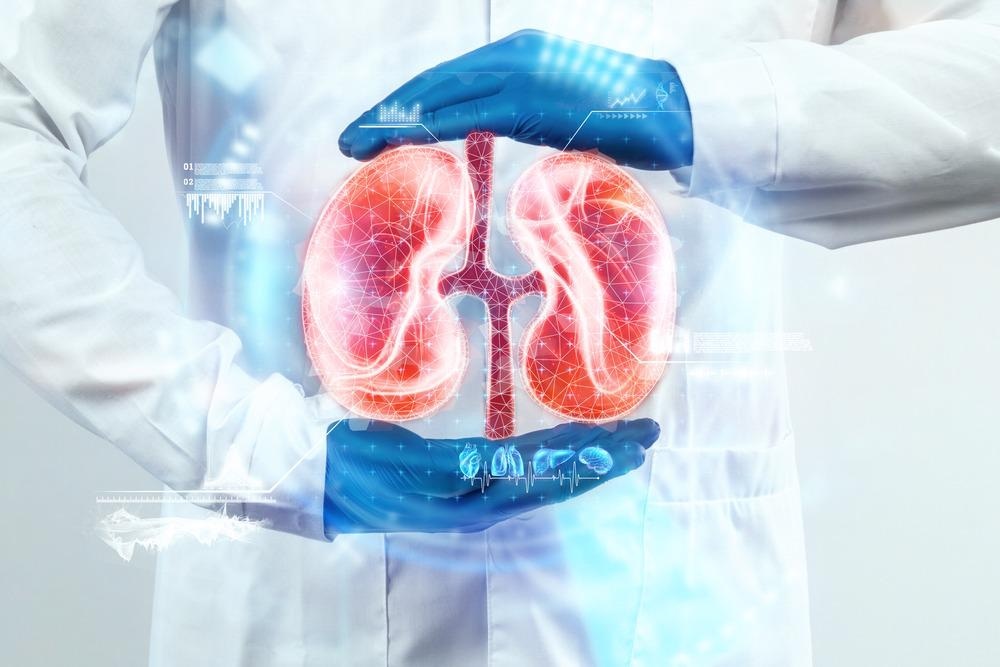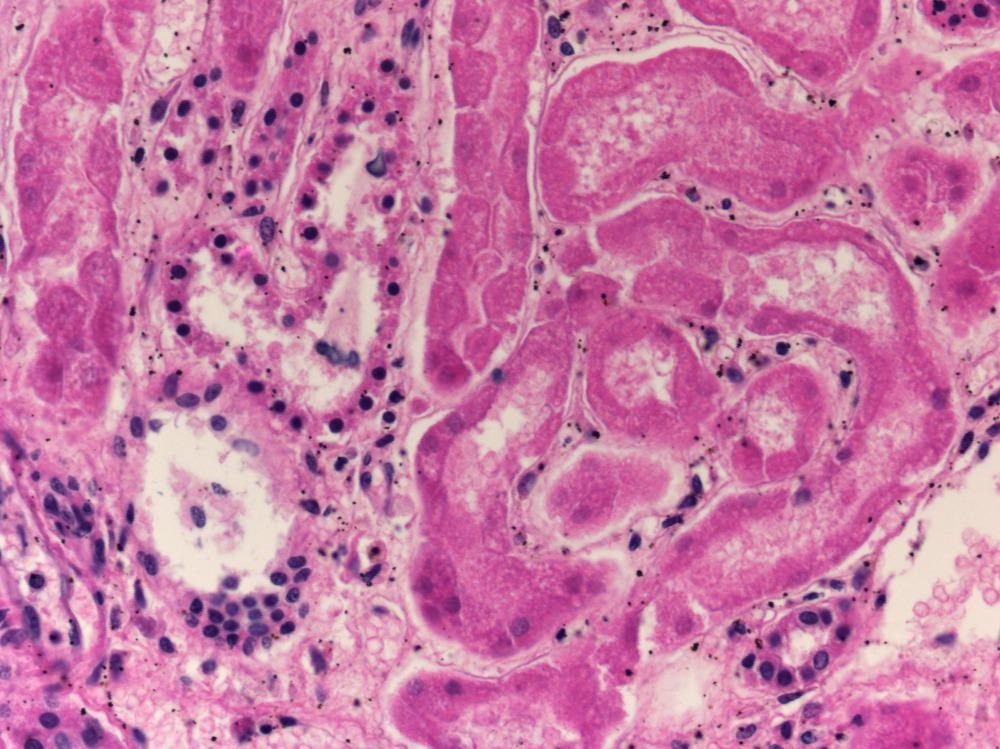Kidney disease has risen as a critical health problem for the global population, especially with diabetes mellitus (DM) becoming ubiquitous in developing countries. Approximately 37 million Americans have chronic kidney disease and critical diabetes statistics report that 1 in 3 people with diabetes develop chronic kidney disease.

Image Credit: Marko Aliaksandr/Shutterstock.com
With the advancement in nanomedicine, developing a less risky and invasive procedure for assessing kidney tissue for diagnostic purposes has become a priority. This would aid in increasing the accuracy of diagnoses and quality of treatments.
While kidney disease is prevalent in the United States, the lack of awareness of this disease in those with this disorder is astounding. Approximately 9 in 10 people have chronic kidney disease without a diagnosis or knowledge about the deficient state of their kidney.
Interestingly, this is due to the early stages of kidney disease that do not present with symptoms, allowing the disorder to progress to advanced stages without detection. The severity of this phenomenon results in adverse health effects, including worsening of kidney function leading to kidney failure and even other health problems such as strokes or a heart attack.
An estimation of 2 in 1000 people within the United States have end-stage kidney disease, which at this current moment can be treated with a kidney transplant or dialysis.
Significance Role of Kidneys
Kidney disease that has been caused by diabetes-related damage is also known as diabetic nephropathy. This is a slow-progressing disease that develops over several years, with 1 in 5 people with this condition requiring treatment.
The significance of this lies within the critical role the kidneys play in the body. The kidneys mainly function as a filter for the blood, with extra fluid and waste products being eliminated via urine, as well as drugs and toxins.
Other significant functions include regulating the water balance through withholding excess water or releasing excess water into the urine. When the former occurs, the result is more water entering blood vessels, which subsequently causes the volume and pressure of the blood to increase.
The varied roles that kidneys play illustrate the requirement for functional kidneys and the critical need for innovative medical solutions to traditional medicine to diagnose and manage kidney disease.
Kidney Disease Challenges
High blood pressure and blood glucose levels can contribute to the damage of the kidneys due to the impact on small blood vessels within these critical organs. This can result in leakage, causing abnormal volumes of protein from the blood to be eliminated through urine, illustrating signs of early kidney disease.
Other symptoms of kidney disease that can be seen with disease progression include swollen ankles, feet and hands, blood in the urine, fatigue, shortness of breath and nausea. This is due to the challenge of kidneys in releasing excess fluid and waste, illustrating the requirement for annual kidney tests for effective functionality, maintaining blood sugar levels and reducing blood pressure.
The gold standard for assessing renal fibrosis is through kidney biopsies and a histopathological assessment. While this approach is used widely, it is known to be a risky and invasive procedure with limited value. This is due to the extent of assessment being so small, with a kidney biopsy examining only 0.01% of kidney tissue and resulting in ineffective diagnoses.
Subsequently, less than 10% of patients use this procedure, which can also have an impact on a healthcare practitioner’s ability to accurately stage the progression of a patient’s disease.
Other challenges faced by traditional medicine include treatment management, such as the suppression of the renin-angiotensin system for the control of hypertension as well as drugs for controlling diabetes. The limitations of these standard treatment options consist of the adverse side effects, comprising hypoglycaemia and diuresis.

Image Credit: Arisang/Shutterstock.om
Innovative Nanomedicine Applications
Nanomedicine has become a branch of medicine that aims to advance traditional notions of diagnostics and therapeutics. This includes using nanoparticles and nanomaterials of a nanosize, usually 1 and 100 nm, with high surface functionalization and targetability to address areas of concern in the body without harming healthier regions.
Nanoparticles can hold great potential for theranostics as they can effectively carry drugs and increase the image contrast when used within bioimaging. This can allow for a wider depth of knowledge of the functionality of a patient’s kidneys without the invasive procedure of a possibly ineffective biopsy.
While nanomedicine and nanoparticles within research have gained traction, with more than twenty nanoparticles receiving FDA approval for cancer treatment, their role in diabetes is still growing.
A few challenges faced by nanoparticles for the treatment of renal disease within several studies have reported having a lack of stability in vivo as well as ineffective targeting within the renal space. The reality of this potential treatment approach surrounds inefficiencies within biodistribution and metabolism.
However, other studies have been more hopeful about this innovative theranostic technique through outlining its promising application in targeting renal tissue. Gaining further understanding of the anatomy of the kidneys is key for utilizing nanoparticles for this function, as this would enable success.
Path to Clinical Success
Further research in this area to improve the application of nanoparticles for renal diseases would include exploring other routes of administration as opposed to the conventional IV that is used, such as intraperitoneal administration. Additionally, nanoparticles require passing through the glomerular filtration membrane and reaching the proximal tubule, requiring the particle size to be less than seven nm, as well as being positively charged.
Another area of research includes surface functionalization, using ligands for targeting renal damage; this can include targeting cell adhesion molecules displayed by inflammatory kidneys such as E-selectin. Targeting these peptides through nanocarriers that release drugs to the target site, such as an immunosuppressant, can aid in managing kidney disease with fewer side effects.
The Centers for Disease Control and Prevention (CDC) reports on chronic kidney disease have found this health disorder to be more common in women (14%) as opposed to men (12%). Additionally, this disease is more common in those aged 65 or older, with a 38% rate.
Further research into innovative solutions such as nanomedicine for theranostics can ensure patients of all ages can be provided with effective diagnoses at an earlier stage and aid in managing kidney disease for a fuller quality of life.
Further Reading and References
States, K. and Health, N., (2022). Kidney Disease Statistics for the United States | NIDDK. [online] National Institute of Diabetes and Digestive and Kidney Diseases. Available at: https://www.niddk.nih.gov/health-information/health-statistics/kidney-disease
Tillman, L., Tabish, T., Kamaly, N., Moss, P., El-briri, A., Thiemermann, C., Pranjol, M. and Yaqoob, M., (2022). Advancements in nanomedicines for the detection and treatment of diabetic kidney disease. Biomaterials and Biosystems, 6, p.100047. Available at: https://doi.org/10.1016/j.bbiosy.2022.100047
UK, D., disease), D., confidence, M. and disease?, L., (2022). Diabetic nephropathy (kidney disease). [online] Diabetes UK. Available at: https://www.diabetes.org.uk/guide-to-diabetes/complications/kidneys_nephropathy
Yamazaki, T., Mimura, I., Tanaka, T. and Nangaku, M., (2021). Treatment of Diabetic Kidney Disease: Current and Future. Diabetes & Metabolism Journal, 45(1), pp.11-26. Available at: 10.4093/dmj.2020.0217
InformedHealth.org [Internet]. Cologne, Germany: Institute for Quality and Efficiency in Health Care (IQWiG); 2006-. How do the kidneys work? 2009 Nov 18 [Updated 2018 Mar 8]. Available from: https://www.ncbi.nlm.nih.gov/books/NBK279385/
Disclaimer: The views expressed here are those of the author expressed in their private capacity and do not necessarily represent the views of AZoM.com Limited T/A AZoNetwork the owner and operator of this website. This disclaimer forms part of the Terms and conditions of use of this website.